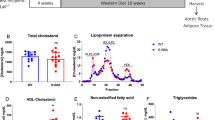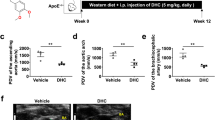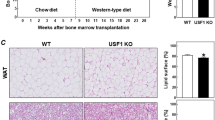Abstract
PPARδ (peroxisome proliferator-activated receptor δ) mediates inflammation in response to lipid accumulation. Systemic administration of a PPARδ agonist can ameliorate atherosclerosis. Paradoxically, genetic deletion of PPARδ in hematopoietic cells led to a reduction of atherosclerosis in murine models, suggesting that downregulation of PPARδ expression in these cells may mitigate atherogenesis. To advance this finding forward to potential clinical translation through hematopoietic stem cell transplantation-based gene therapy, we employed a microRNA (miRNA) approach to knock down PPARδ expression in bone marrow cells followed by transplantation of the cells into LDLR−/− mice. We found that knockdown of PPARδ expression in the hematopoietic system caused a dramatic reduction in aortic atherosclerotic lesions. In macrophages, a key component in atherogenesis, knockdown of PPARδ led to decreased expression of multiple pro-inflammatory factors, including monocyte chemoattractant protein-1 (MCP-1), interleukin (IL)-1β and IL-6. Expression of CCR2, a receptor for MCP-1, was also decreased. The downregulation of pro-inflammatory factors is consistent with significant reduction of macrophage presence in the lesions, which may also be attributable to elevation of ABCA1 (ATP-binding cassette, subfamily A, member 1) and depression of adipocyte differentiate-related protein. Furthermore, the abundance of both MCP-1 and matrix metalloproteinase-9 proteins was reduced in plaque areas. Our results demonstrate that miRNA-mediated PPARδ knockdown in hematopoietic cells is able to ameliorate atherosclerosis.
This is a preview of subscription content, access via your institution
Access options
Subscribe to this journal
Receive 12 print issues and online access
$259.00 per year
only $21.58 per issue
Buy this article
- Purchase on Springer Link
- Instant access to full article PDF
Prices may be subject to local taxes which are calculated during checkout






Similar content being viewed by others
References
Berger J, Moller DE . The mechanisms of action of PPARs. Ann Rev Med 2002; 53: 409–435.
Ricote M, Glass CK . PPARs and molecular mechanisms of transrepression. Biochim Biophys Acta 2007; 1771: 926–935.
Schnegg CI, Kooshki M, Hsu FC, Sui G, Robbins ME . PPARdelta prevents radiation-induced proinflammatory responses in microglia via transrepression of NF-kappaB and inhibition of the PKCalpha/MEK1/2/ERK1/2/AP-1 pathway. Free Radic Biol Med 2012; 52: 1734–1743.
Serrano-Marco L, Barroso E, El KI, Palomer X, Michalik L, Wahli W et al. The peroxisome proliferator-activated receptor (PPAR) beta/delta agonist GW501516 inhibits IL-6-induced signal transducer and activator of transcription 3 (STAT3) activation and insulin resistance in human liver cells. Diabetologia 2012; 55: 743–751.
Iwaki M, Matsuda M, Maeda N, Funahashi T, Matsuzawa Y, Makishima M et al. Induction of adiponectin, a fat-derived antidiabetic and antiatherogenic factor, by nuclear receptors. Diabetes 2003; 52: 1655–1663.
Barish GD, Narkar VA, Evans RM . PPAR delta: a dagger in the heart of the metabolic syndrome. J Clin Invest 2006; 116: 590–597.
Benetti E, Patel NS, Collino M . The role of PPARbeta/delta in the management of metabolic syndrome and its associated cardiovascular complications. Endocr Metab Immune Disord Drug Targets 2011; 11: 273–284.
Berger JP, Akiyama TE, Meinke PT . PPARs: therapeutic targets for metabolic disease. Trends Pharmacol Sci 2005; 26: 244–251.
Barish GD, Atkins AR, Downes M, Olson P, Chong LW, Nelson M et al. PPARdelta regulates multiple proinflammatory pathways to suppress atherosclerosis. Proc Natl Acad Sci USA 2008; 105: 4271–4276.
Coll T, Barroso E, Alvarez-Guardia D, Serrano L, Salvado L, Merlos M et al. The role of peroxisome proliferator-activated receptor beta/delta on the inflammatory basis of metabolic disease. PPAR Res 2010; 2010: 1–11.
Ding G, Cheng L, Qin Q, Frontin S, Yang Q . PPARdelta modulates lipopolysaccharide-induced TNFalpha inflammation signaling in cultured cardiomyocytes. J Mol Cell Cardiol 2006; 40: 821–828.
Planavila A, Laguna JC, Vazquez-Carrera M . Nuclear factor-kappaB activation leads to down-regulation of fatty acid oxidation during cardiac hypertrophy. J Biol Chem 2005; 280: 17464–17471.
Serrano-Marco L, Rodriguez-Calvo R, El K, Palomer I, Michalik X, Wahli L et al. Activation of peroxisome proliferator-activated receptor-beta/-delta (PPAR-beta/-delta) ameliorates insulin signaling and reduces SOCS3 levels by inhibiting STAT3 in interleukin-6-stimulated adipocytes. Diabetes 2011; 60: 1990–1999.
Zingarelli B, Piraino G, Hake PW, O’Connor M, Denenberg A, Fan H et al. Peroxisome proliferator-activated receptor {delta} regulates inflammation via NF-{kappa}B signaling in polymicrobial sepsis. Am J Pathol 2010; 177: 1834–1847.
Lee CH, Chawla A, Urbiztondo N, Liao D, Boisvert WA, Evans RM . Transcriptional repression of atherogenic inflammation: modulation by PPARδ. Science 2003; 302: 453–457.
Bojic LA, Burke AC, Chhoker SS, Telford DE, Sutherland BG, Edwards JY et al. Peroxisome proliferator-activated receptor delta agonist GW1516 attenuates diet-induced aortic inflammation, insulin resistance, and atherosclerosis in low-density lipoprotein receptor knockout mice. Arterioscler Thromb Vasc Biol 2014; 34: 52–60.
Brunelli L, Cieslik KA, Alcorn JL, Vatta M, Baldini A . Peroxisome proliferator-activated receptor-δ upregulates 14-3-3 epsilon in human endothelial cells via CCAAT/enhancer binding protein-beta. Circ Res 2007; 100: e59–e71.
d’Uscio LV, Das P, Santhanam AVR, He T, Younkin SG, Katusic ZS . Activation of PPARδ prevents endothelial dysfunction induced by overexpression of amyloid-β precursor protein. Cardiovasc Res 2012; 96: 504–512.
Quintela AM, Jiménez R, Gómez-Guzmán M, Zarzuelo MaJ, Galindo P, Sánchez M et al. Activation of peroxisome proliferator-activated receptor-β/-δ (PPARβ/δ) prevents endothelial dysfunction in type 1 diabetic rats. Free Radic Biol Med 2012; 53: 730–741.
Sprecher DL, Massien C, Pearce G, Billin AN, Perlstein I, Willson TM et al. Triglyceride:high-density lipoprotein cholesterol effects in healthy subjects administered a peroxisome proliferator activated receptor delta agonist. Arterioscler Thromb Vasc Biol 2007; 27: 359–365.
Takata Y, Liu J, Yin F, Collins AR, Lyon CJ, Lee CH et al. PPARdelta-mediated antiinflammatory mechanisms inhibit angiotensin II-accelerated atherosclerosis. Proc Natl Acad Sci USA 2008; 105: 4277–4282.
Graham TL, Mookherjee C, Suckling KE, Palmer CN, Patel L . The PPARdelta agonist GW0742X reduces atherosclerosis in LDLR(-/-) mice. Atherosclerosis 2005; 181: 29–37.
Li AC, Binder CJ, Gutierrez A, Brown KK, Plotkin CR, Pattison JW et al. Differential inhibition of macrophage foam-cell formation and atherosclerosis in mice by PPARalpha, beta/delta, and gamma. J Clin Invest 2004; 114: 1564–1576.
Reilly SM, Lee CH . PPAR delta as a therapeutic target in metabolic disease. FEBS Lett 2008; 582: 26–31.
Takahashi S, Tanaka T, Kodama T, Sakai J . Peroxisome proliferator-activated receptor delta (PPARdelta), a novel target site for drug discovery in metabolic syndrome. Pharmacol Res 2006; 53: 501–507.
Imamura M, Inoguchi T, Ikuyama S, Taniguchi S, Kobayashi K, Nakashima N et al. ADRP stimulates lipid accumulation and lipid droplet formation in murine fibroblasts. Am J Physiol Endocrinol Metab 2002; 283: E775–E783.
Kleemann R, Zadelaar S, Kooistra T . Cytokines and atherosclerosis: a comprehensive review of studies in mice. Cardiovasc Res 2008; 79: 360–376.
Fan Y, Wang Y, Tang Z, Zhang H, Qin X, Zhu Y et al. Suppression of pro-inflammatory adhesion molecules by PPAR-delta in human vascular endothelial cells. Arterioscler Thromb Vasc Biol 2008; 28: 315–321.
Li Z, Wang X, Yu RY, Ding BB, Yu JJ, Dai XM et al. BCL-6 negatively regulates expression of the NF-kappaB1 p105/p50 subunit. J Immunol 2005; 174: 205–214.
Boring L, Gosling J, Cleary M, Charo IF . Decreased lesion formation in CCR2-/- mice reveals a role for chemokines in the initiation of atherosclerosis. Nature 1998; 394: 894–897.
Di PR, Esposito E, Mazzon E, Paterniti I, Galuppo M, Cuzzocrea S . GW0742, a selective PPAR-beta/delta agonist, contributes to the resolution of inflammation after gut ischemia/reperfusion injury. J Leukoc Biol 2010; 88: 291–301.
Lim HJ, Park JH, Lee S, Choi HE, Lee KS, Park HY . PPARdelta ligand L-165041 ameliorates Western diet-induced hepatic lipid accumulation and inflammation in LDLR-/- mice. Eur J Pharmacol 2009; 622: 45–51.
Girroir EE, Hollingshead HE, He P, Zhu B, Perdew GH, Peters JM . Quantitative expression patterns of peroxisome proliferator-activated receptor-beta/delta (PPARbeta/delta) protein in mice. Biochem Biophys Res Commun 2008; 371: 456–461.
Higashiyama H, Billin AN, Okamoto Y, Kinoshita M, Asano S . Expression profiling of peroxisome proliferator-activated receptor-delta (PPAR-delta) in mouse tissues using tissue microarray. Histochem Cell Biol 2007; 127: 485–494.
Gupta RA, Tan J, Krause WF, Geraci MW, Willson TM, Dey SK et al. Prostacyclin-mediated activation of peroxisome proliferator-activated receptor delta in colorectal cancer. Proc Natl Acad Sci USA 2000; 97: 13275–13280.
Pedchenko TV, Gonzalez AL, Wang D, DuBois RN, Massion PP . Peroxisome proliferator-activated receptor beta/delta expression and activation in lung cancer. Am J Respir Cell Mol Biol 2008; 39: 689–696.
Scholtysek C, Katzenbeisser J, Fu H, Uderhardt S, Ipseiz N, Stoll C et al. PPARbeta/delta governs Wnt signaling and bone turnover. Nat Med 2013; 19: 608–613.
Takayama O, Yamamoto H, Damdinsuren B, Sugita Y, Ngan CY, Xu X et al. Expression of PPARdelta in multistage carcinogenesis of the colorectum: implications of malignant cancer morphology. Br J Cancer 2006; 95: 889–895.
Wagner KD, Benchetrit M, Bianchini L, Michiels JF, Wagner N . Peroxisome proliferator-activated receptor beta/delta (PPARbeta/delta) is highly expressed in liposarcoma and promotes migration and proliferation. J Pathol 2011; 224: 575–588.
Yang L, Yu YY, Zhou ZG, Luo HZ, Zhou B, Tian C et al. Quantification of PPARdelta mRNA by real-time RT-PCR in rectal cancer tissues. Sichuan Da Xue Xue Bao Yi Xue Ban 2007; 38: 78–80.
Yang L, Zhang H, Zhou ZG, Yan H, Adell G, Sun XF . Biological function and prognostic significance of peroxisome proliferator-activated receptor delta in rectal cancer. Clin Cancer Res 2011; 17: 3760–3770.
Zeng L, Geng Y, Tretiakova M, Yu X, Sicinski P, Kroll TG . Peroxisome proliferator-activated receptor-delta induces cell proliferation by a cyclin E1-dependent mechanism and is up-regulated in thyroid tumors. Cancer Res 2008; 68: 6578–6586.
Thulin P, Wei T, Werngren O, Cheung L, Fisher RM, Grander D et al. MicroRNA-9 regulates the expression of peroxisome proliferator-activated receptor delta in human monocytes during the inflammatory response. Int J Mol Med 2013; 31: 1003–1010.
Jguirim-Souissi I, Jelassi A, Hrira Y, Najah M, Slimani A, Addad F et al. +294T/C polymorphism in the PPAR-delta gene is associated with risk of coronary artery disease in normolipidemic Tunisians. Genet Mol Res 2010; 9: 1326–1333.
Charo IF, Taubman MB . Chemokines in the pathogenesis of vascular disease. Circ Res 2004; 95: 858–866.
Fan J, Watanabe T . Inflammatory reactions in the pathogenesis of atherosclerosis. J Atheroscler Thromb 2003; 10: 63–71.
Norata GD, Grigore L, Raselli S, Redaelli L, Hamsten A, Maggi F et al. Post-prandial endothelial dysfunction in hypertriglyceridemic subjects: molecular mechanisms and gene expression studies. Atherosclerosis 2007; 193: 321–327.
Aberle J, Hopfer I, Beil FU, Seedorf U . Association of peroxisome proliferator-activated receptor delta +294T/C with body mass index and interaction with peroxisome proliferator-activated receptor alpha L162V. Int J Obes (Lond) 2006; 30: 1709–1713.
Burch LR, Donnelly LA, Doney AS, Brady J, Tommasi AM, Whitley AL et al. Peroxisome proliferator-activated receptor-delta genotype influences metabolic phenotype and may influence lipid response to statin therapy in humans: a genetics of diabetes audit and research Tayside study. J Clin Endocrinol Metab 2010; 95: 1830–1837.
Gu SJ, Guo ZR, Zhou ZY, Hu XS, Wu M . PPAR alpha and PPAR gamma polymorphisms as risk factors for dyslipidemia in a Chinese Han population. Lipids Health Dis 2014; 13: 23.
He W, Qiang M, Ma W, Valente AJ, Quinones MP, Wang W et al. Development of a synthetic promoter for macrophage gene therapy. Hum Gene Ther 2006; 17: 949–959.
Pawliuk R, Westerman KA, Fabry ME, Payen E, Tighe R, Bouhassira EE et al. Correction of sickle cell disease in transgenic mouse models by gene therapy. Science 2001; 294: 2368–2371.
Acknowledgements
We thank Xiaoling Xue and Qiong Zhang for excellent laboratory assistance. This study was supported by a Merit Review grant from the Research Division of the Department of Veterans Affairs and by a grant from William and Ella Owens Medical Research Foundation awarded to SL. RAC is supported by Clinical and Translational Science Award TR001120 from the National Institutes of Health. This study was supported by a grant from the US Veterans Health Administration.
Author information
Authors and Affiliations
Corresponding author
Ethics declarations
Competing interests
The authors declare no conflict of interest.
Rights and permissions
About this article
Cite this article
Li, G., Chen, C., Laing, S. et al. Hematopoietic knockdown of PPARδ reduces atherosclerosis in LDLR−/− mice. Gene Ther 23, 78–85 (2016). https://doi.org/10.1038/gt.2015.78
Received:
Revised:
Accepted:
Published:
Issue Date:
DOI: https://doi.org/10.1038/gt.2015.78
This article is cited by
-
Implications of metabolism-driven myeloid dysfunctions in cancer therapy
Cellular & Molecular Immunology (2021)
-
Primary prevention of atherosclerosis by pretreatment of low-density lipoprotein receptor knockout mice with sesame oil and its aqueous components
Scientific Reports (2018)
-
Pharmacological Activation of Peroxisome Proliferator-Activated Receptor {Delta} Increases Sphingomyelin Synthase Activity in THP-1 Macrophage-Derived Foam Cell
Inflammation (2016)



